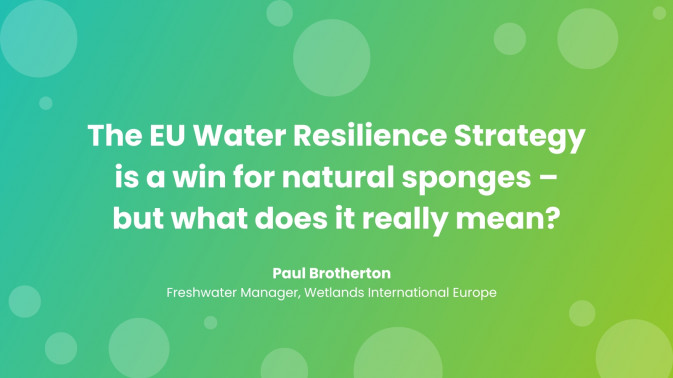
The EU Water Resilience Strategy is a win for natural sponges – but what does it really mean?
The EU Water Resilience Strategy (WRS) was announced on 4 June after growing calls for more coordinated action to ensure water security and prepare for water-related disasters in the face of increasing droughts and floods. Restoring and protecting the water cycle is the first key objective, with the recognition that the full potential of our ecosystems is needed to improve water retention on land – with “the need to redress the natural sponge function of our landscapes” and a proposal for a “Sponge Facility”.
This gives natural sponges a prominent place in the EU’s much anticipated initiative to put water resilience at the top of the political agenda, and should make the concept more familiar to decision makers, from EU to national and local level. This is important so that natural sponge measures are more widely implemented on the ground in the strategies and plans for EU legislation on agriculture, floods, nature restoration and freshwater.
Wetlands International Europe advocated for a EU Sponge Facility the past 18 months, and has been at the forefront of developing the knowledge base, testing and deploying natural sponges with many partners, including the Horizon SpongeBoost project. Our own research and experience shows the potential of natural sponges to achieve multiple policy objectives while making the public safer by limiting floods, increasing water supplies, improving water quality and supporting healthy nature.
There is an urgent need to dramatically scale up investment and deployment of natural sponges and other such nature-based solutions (NbS). There are an increasing number of natural sponge pilots around Europe, but to date the combination of insufficient technical assistance, tools, incentives and financing has made it difficult to scale up to larger landscapes – more sponge champions are needed, including government authorities, private landowners including the agricultural sector, the private sector and financial institutions.
Here are some of the elements of the WRS that can benefit natural sponges:
- The aim of the Sponge Facility is to create a coherent framework for new and existing initiatives to increase water retention on land. This bears watching as more attention and coordination will help, but it is disappointing that it was not included among the flagship actions under this objective as the current water and climate crises calls for bigger, bolder action to truly make Europe more resilient. It is also unfortunate that the funding mechanism for the Sponge Facility was not addressed explicitly, and no new incentives or tools were introduced to catalyse it.
- A flagship action is included under governance for the Cohesion for Transitions Community of Practice to organise regular exchanges with regions, cities and water authorities on “sponge landscapes” and transboundary water cooperation.
- The Green and Blue Corridors initiative has the potential to put ecosystem restoration at the heart of water resilience. It could be transformational if it treats the restoration of natural infrastructure including rivers, floodplain sponges and coastal wetlands as critical infrastructure as in California and Canada.
- Initiatives in the financing and investment section of the WRS can help address the gap in deploying and upscaling natural sponges, including: rewarding ecosystem services schemes, a Water Resilience Investment Accelerator, more favourable policies on funding water resilience under Cohesion policy and more technical assistance.
- Enhanced cooperation with the European Investment Bank (EIB) is a welcome step, along with the commitment of EUR 15 billion during 2025-2027 for projects including NbS. But funding for NbS by the EIB has been limited and tricky to date, with traditional infrastructure often viewed as bankable while NbS more uncertain. More work is needed to ensure that NbS are at the core of investments rather than add-ons when it comes to critical infrastructure.
The coming months and years will be critical for implementing the WRS. With our partners in SpongeBoost and in sister projects such as SpongeScapes, we will be working to put the natural sponge elements of the WRS into action.
Paul Brotherton
Freshwater Manager, Wetlands International Europe